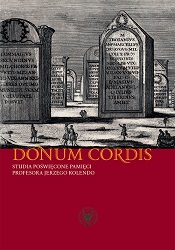Moneta Gajusza (Kaliguli), wybita dla Marka Agryppy, znaleziona w Radomiu
The coin of Gaius (Caligula), issued for Marcus Agrippa, found in Radom
Author(s): Renata Ciołek
Subject(s): Archaeology
Published by: Wydawnictwa Uniwersytetu Warszawskiego
Keywords: Jerzy Kolendo; archaeology; Poland; Europe; University of Warsaw; Polish Academy of Sciences
Summary/Abstract: The oldest Roman coins discovered in the Polish territories come from the Roman Republic period. Untilrecently, these coins were treated with suspicion and each was subject to careful analysis to confi rm its authenticity.This also applied to fi ndings of early-imperial coins. This is why the information about the fi nding ofan as, a bronze coin, showing Marcus Agrippa, issued in Rome under Caligula’s reign (37–41), has aroused somuch interest. Coins of this type are extremely rare specimens, even in the territories of the Roman Empire, notto mention the area of the Barbaricum. For this reason, it is important to study each specimen and to considerits authenticity. On Polish territories, emissions of Caligula for Marcus Agrippa have been unknown so far. Thefi nding, in my opinion, is not certain. It is only known that the coin was found many years ago by a student onthe outskirts of Radom or on the property where a student of the Faculty of History of the University of Warsawwas living. This would be the fi rst specimen then. The article presents the most important fi ndings of RomanRepublican and early-imperial coins from the area of Poland and its vicinity.Republican and early-imperial coins from the period up to 64 AD could have travelled to the areas north ofthe middle Danube in the second half of the 1st century AD and some of them could have arrived there probablyat the beginning of the 2nd century. On the territories of the Roman state, those emissions were in use for a verylong time, offi cially until 107 when Trajan withdrew them from circulation through a legal act. Even after thisreform, Republican specimens were not completely eliminated from use, as indicated by treasures from the endof the 2nd and the beginning of the 3rd century. Earlier political contacts between tribes inhabiting in the 1st centuryAD the areas of present-day Małopolska and the people of the South are attested by coins from the treasurefrom Połaniec.
Book: Donum cordis. Studia poświęcone pamięci Profesora Jerzego Kolendo
- Page Range: 75-81
- Page Count: 6
- Publication Year: 2019
- Language: English, Polish, German
- Content File-PDF

